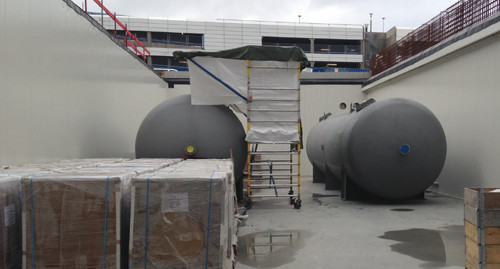
PCM-assisted cooling system designed to cut energy costs at Norwegian airport
A PCM-based thermal energy storage system at a new airport terminal in Bergen, Norway, is designed to reduce energy costs by chilling water overnight, when ambient temperatures are lower.
To handle peak demand during summer, Bergen Airport required a cooling system with a maximum output of 5 megawatts, said civil engineer Rune Teigland, who designed the system.
Instead, chillers with a maximum output of just 2.5 megawatts were installed. An additional 11,000 kWh of cooling can be drawn from four large tanks that hold 44,000 panels filled with a modified salt-based phase change material. The PCM has a melting point of about 10º Celsius. The HDPE panels act as thermal batteries, holding the “chill” produced overnight for use during the day.
“The obvious advantage is that the cooling plant does not need to be big enough to handle the maximum cooling requirement. This offers some clear benefits, in terms of price, energy consumption and maintenance,” explained Teigland, a project leader and energy specialist at COWI of Lyngby, Denmark.
The panels, supplied by U.K.-based PCM Products Ltd., are 50x25x3 centimeters in size and are stacked on top of each other in the water-filled tanks. Each tank is 13 meters long and 3 meters in diameter.
When water at a temperature below the PCM’s freezing point is passed through the tanks, the PCM solidifies and energy is stored in the panels. When water is fed in at a temperature above the PCM’s freezing point, the PCM will melt and produce a cooling effect.
COWI says the system can run for two hours at full capacity solely on the energy stored in the PCM panels. The company projects an annual savings of 5,000 megawatt-hours compared to a conventional system.
“The method provides for big savings in energy and running costs, and we see great potential for buildings, data centers and production halls, which need to keep both temperatures and CO₂ emissions down. This method could change the whole cooling industry,” said Teigland.
Teigland said he began “measuring and logging” system performance a few months before the terminal opened in August. He plans to submit a paper about the project to ASHRAE. He offered these additional comments on the project:
"In an ordinary system one would install 5 MW with mechanical cooling. This means that at least 50% of the chillers rarely would be running, maybe only a few weeks in summer. A chiller or any refrigeration compressor is designed to be running. In long stand-still periods, flex gaskets will dry up which may result in refrigerant leaks and even engine damage. In summer time when maximum cooling capacity is needed we will first have to repair chillers that have had a long time with stand still.
"We try to choose a more environmentally sustainable approach to this situation and we like to be in front of the technical development.
"We even use the tanks in winter to try to obtain maximum COP from chillers running. If one chiller is running and the next one is only on low partial load we would rather supply with energy from the tanks to avoid low partial load."
For more on the project, see: http://www.cowi.com/menu/newsandmedia/news/industryandenergy/storing-energy-in-brine-cells-can-reduce-co%E2%82%82--emissions
For the latest news and research on phase change material and thermal energy storage, subscribe to Phase Change Matters, the award-winning weekly newsletter.


BEng (Mech.), MRINA. Delivering results for Bastion Defence Consulting and our clients.
6yEric Hu